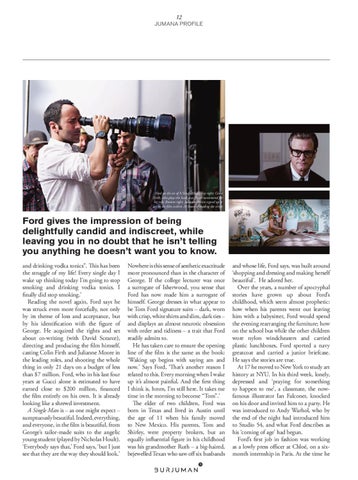12
JUMANA PROFILE
Ford on the set of A Single Man; Top right: Colin Firth, who plays the lead, was Oscar-nominated for his role; Bottom right: Julianne Moore signed up to act in the film within 24 hours of reading the script
Ford gives the impression of being delightfully candid and indiscreet, while leaving you in no doubt that he isn’t telling you anything he doesn’t want you to know. and drinking vodka tonics”. This has been the struggle of my life! Every single day I wake up thinking today I’m going to stop smoking and drinking vodka tonics. I finally did stop smoking.’ Reading the novel again, Ford says he was struck even more forcefully, not only by its theme of loss and acceptance, but by his identification with the figure of George. He acquired the rights and set about co-writing (with David Scearce), directing and producing the film himself, casting Colin Firth and Julianne Moore in the leading roles, and shooting the whole thing in only 21 days on a budget of less than $7 million. Ford, who in his last four years at Gucci alone is estimated to have earned close to $200 million, financed the film entirely on his own. It is already looking like a shrewd investment. A Single Man is – as one might expect – sumptuously beautiful. Indeed, everything, and everyone, in the film is beautiful, from George’s tailor-made suits to the angelic young student (played by Nicholas Hoult). ‘Everybody says that,’ Ford says, ‘but I just see that they are the way they should look.’
Nowhere is this sense of aesthetic exactitude more pronounced than in the character of George. If the college lecturer was once a surrogate of Isherwood, you sense that Ford has now made him a surrogate of himself. George dresses in what appear to be Tom Ford signature suits – dark, worn with crisp, white shirts and slim, dark ties – and displays an almost neurotic obsession with order and tidiness – a trait that Ford readily admits to. He has taken care to ensure the opening line of the film is the same as the book: ‘Waking up begins with saying am and now.’ Says Ford, ‘That’s another reason I related to this. Every morning when I wake up it’s almost painful. And the first thing I think is, hmm, I’m still here. It takes me time in the morning to become “Tom”.’ The elder of two children, Ford was born in Texas and lived in Austin until the age of 11 when his family moved to New Mexico. His parents, Tom and Shirley, were property brokers, but an equally influential figure in his childhood was his grandmother Ruth – a big-haired, bejewelled Texan who saw off six husbands
and whose life, Ford says, was built around ‘shopping and dressing and making herself beautiful’. He adored her. Over the years, a number of apocryphal stories have grown up about Ford’s childhood, which seem almost prophetic: how when his parents went out leaving him with a babysitter, Ford would spend the evening rearranging the furniture; how on the school bus while the other children wore nylon windcheaters and carried plastic lunchboxes, Ford sported a navy greatcoat and carried a junior briefcase. He says the stories are true. At 17 he moved to New York to study art history at NYU. In his third week, lonely, depressed and ‘praying for something to happen to me’, a classmate, the nowfamous illustrator Ian Falconer, knocked on his door and invited him to a party. He was introduced to Andy Warhol, who by the end of the night had introduced him to Studio 54, and what Ford describes as his ‘coming of age’ had begun. Ford’s first job in fashion was working as a lowly press officer at Chloé, on a sixmonth internship in Paris. At the time he
